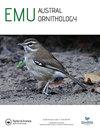Divided by the range: evidence for geographic isolation of the highly mobile Emu (Dromaius novaehollandiae)
IF 1.1
4区 生物学
Q3 ORNITHOLOGY
引用次数: 0
Abstract
ABSTRACT Conserving evolutionary processes is becoming increasingly important in conservation management as environmental changes continue to threaten wild populations. Characterising genetically distinct populations and assessing connectivity across the landscape enables wildlife managers to prioritise conservation efforts with limited resources. In the NSW North Coast bioregion of Australia, one of the last remaining coastal populations of the Emu (Dromaius novaehollandiae) has been state-listed as an Endangered Population, owing to its geographic isolation and small census size. Using mitochondrial and nuclear genetic markers, we examined the spatial genetic structure and diversity of Emus across south-eastern Australia. For the NSW North Coast population, we estimated the effective population size ( ) and carried out simulations to predict future levels of genetic variation. We show significant genetic divergence between the NSW North Coast Emu and other localities based on thousands of highly resolving nuclear markers. Among NSW North Coast Emus, we found less genetic diversity and a critically low-effective population size ( = 14.84 and 22.49 based on independent methods). Our simulations predict that the of the NSW North Coast Emu population is insufficient to maintain genetic diversity and the population may be at risk of inbreeding depression. Incorporating genetic data into the design of captive-release and translocation projects would refine management plans for this locally important population and monitor risks to its long-term survival.按范围划分:高度移动的鸸鹋(新荷兰鸸鹋科)地理隔离的证据
随着环境变化对野生种群的持续威胁,保护进化过程在保护管理中变得越来越重要。描述遗传上不同的种群特征和评估整个景观的连通性,使野生动物管理者能够在资源有限的情况下优先考虑保护工作。在澳大利亚的新南威尔士州北海岸生物区,由于其地理隔离和人口普查规模小,最后剩余的沿海鸸鹋种群之一(新荷兰鸸鹋)已被国家列为濒危种群。利用线粒体和核遗传标记,研究了澳大利亚东南部鸸鹋的空间遗传结构和多样性。对于新南威尔士州北海岸的种群,我们估计了有效的种群规模(),并进行了模拟来预测未来的遗传变异水平。我们显示新南威尔士州北海岸鸸鹋和其他地区之间的显著遗传差异基于数千个高分辨率的核标记。在新南威尔士州北海岸的鸸鹋中,我们发现遗传多样性较少,有效种群规模极低(分别为14.84和22.49)。我们的模拟预测,新南威尔士州北海岸的鸸鹋种群不足以维持遗传多样性,种群可能面临近亲繁殖衰退的风险。将基因数据纳入圈养放生和迁移项目的设计中,将完善这一当地重要种群的管理计划,并监测其长期生存的风险。
本文章由计算机程序翻译,如有差异,请以英文原文为准。
求助全文
约1分钟内获得全文
求助全文
来源期刊

Emu-Austral Ornithology
生物-鸟类学
CiteScore
2.00
自引率
7.70%
发文量
33
审稿时长
>12 weeks
期刊介绍:
Emu – Austral Ornithology is the premier journal for ornithological research and reviews related to the Southern Hemisphere and adjacent tropics. The journal has a long and proud tradition of publishing articles on many aspects of the biology of birds, particularly their conservation and management.
 求助内容:
求助内容: 应助结果提醒方式:
应助结果提醒方式:


